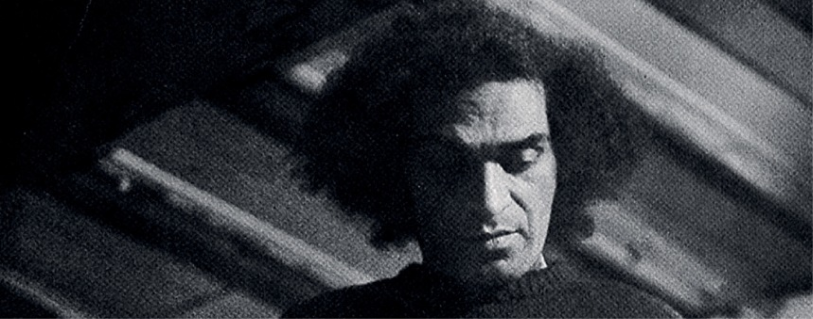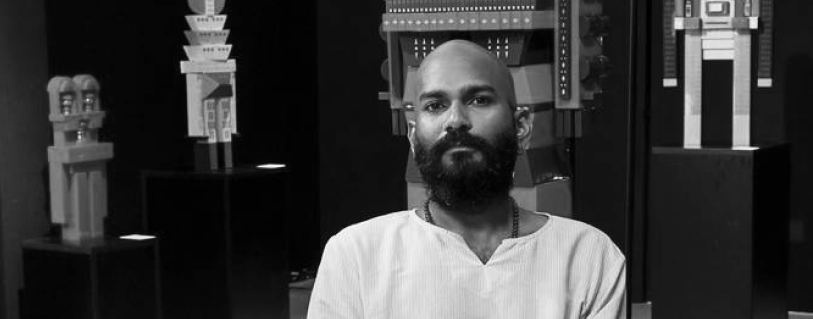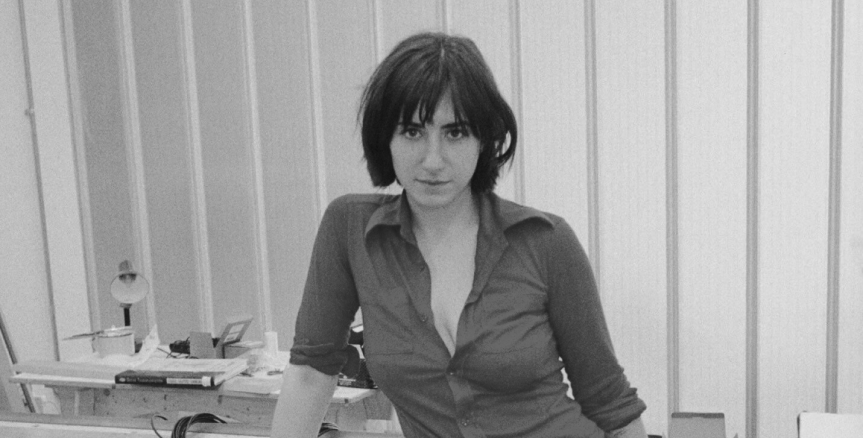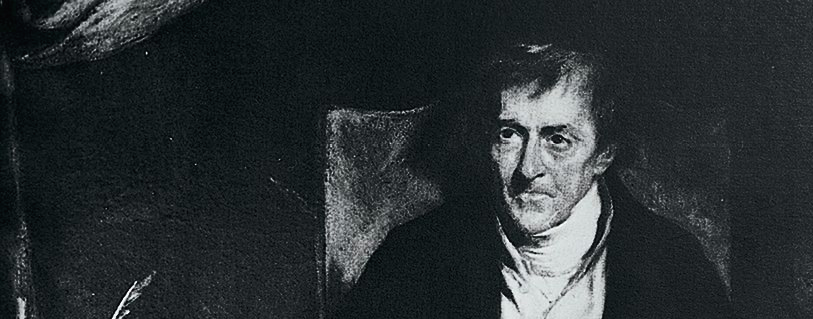Our artists call to us across geography and time. Their works of art are the traces of lives spent unapologetically, in unequivocally unique ways.
Through our collection, our desire is to break boundaries that divide us in search of a common understanding and share our combined passion for art.
Send us your details and we’ll get back to you at the earliest.

Threads of spirituality and rhythm entangle themselves in Sohan Qadri’s work. If it is awakening you’re after, there are few others who would guide you inward like him.
Sohan Qadri was born in 1932 in Punjab. His pursuit of universal truths began in the school of his first teacher, Bhikan Giri.
Not long after turning twenty, Sohan fled to a Himalayan monastery where he learned for a year between 1953 and 1954. When he returned, he was still eager to escape. Then, Qadri took up formal artistic training at the Government College of Art in Chandigarh, India. Again, in 1965, Qadri set off again through East Africa, France, and Switzerland, before settling in Copenhagen where he spent most of his life.
Ultimately, he travelled to Toronto, in the 1980s where he spent a considerable part of his later life and passed away in 2011. Behind him however, Sohan Qadri left an indelible mark and legacy of exploration and introspection through his striking body of work. His influence continues to be felt for its synthesis of Eastern spirituality and Western modernism.

Kumkum champions his Srilankan heritage and bridges the gap between traditional art and contemporary forms with ease.
Kumkum was born in Sri Lanka. As a son of an antique collector, collecting curiosities ran in his blood. For as long as memory serves, Kumkum has been a collector; of stones, spoons, statues, masks, and other marvels and treasures. Thousands of years of Sri Lankan culture inform Kumkum’s art, from ornate temple paintings to folktales of portals that connect us to a vast underworld of gods, giants and demons.
He champions this inspiration from heritage by bridging art and design with his deep appreciation for ancient and traditional forms. From his home in Vietnam, Kumkum scours the streets for materials—patterns, shapes and colours— to reanimate into art.

Kumkum champions his Srilankan heritage and bridges the gap between traditional art and contemporary forms with ease.
Kumkum was born in Sri Lanka. As a son of an antique collector, collecting curiosities ran in his blood. For as long as memory serves, Kumkum has been a collector; of stones, spoons, statues, masks, and other marvels and treasures. Thousands of years of Sri Lankan culture inform Kumkum’s art, from ornate temple paintings to folktales of portals that connect us to a vast underworld of gods, giants and demons.
He champions this inspiration from heritage by bridging art and design with his deep appreciation for ancient and traditional forms. From his home in Vietnam, Kumkum scours the streets for materials—patterns, shapes and colours— to reanimate into art.

Charlotte Seux is a French-American artist currently living in London. Her work with sculpture, language, and video explores and confronts her relationship to power and systems that control and regulate bodies.
Her work illuminates the unseen forces that shape consumerist lives and draws heavily from the interplay between the bio(productive) and necro(destructive) forces that create and shape them. Minimalist in her application, and disruptive hence. It invites the viewer to engage with these elusive systems of control. Blurring the position between the subject/object.

Threads of spirituality and rhythm entangle themselves in Sohan Qadri’s work. If it is awakening you’re after, there are few others who would guide you inward like him.
Sohan Qadri was born in 1932 in Punjab. His pursuit of universal truths began in the school of his first teacher, Bhikan Giri.
Not long after turning twenty, Sohan fled to a Himalayan monastery where he learned for a year between 1953 and 1954. When he returned, he was still eager to escape. Then, Qadri took up formal artistic training at the Government College of Art in Chandigarh, India. Again, in 1965, Qadri set off again through East Africa, France, and Switzerland, before settling in Copenhagen where he spent most of his life.
Ultimately, he travelled to Toronto, in the 1980s where he spent a considerable part of his later life and passed away in 2011. Behind him however, Sohan Qadri left an indelible mark and legacy of exploration and introspection through his striking body of work. His influence continues to be felt for its synthesis of Eastern spirituality and Western modernism.

Unrivalled in his documentation of India through art, Thomas Daniell arrived here in 1786. What followed was creations that are celebrated across the world, centuries after.
From presidencies to people, customs to curiosities, flora, fauna and even famed sites—Thomas Daniell spent a decade painting, sketching and discovering India in every easel he touched. He was one of the first from England to do so. In his work, you’ll stand at the banks of the Ganga, or in a wooded forest of the south, perhaps even Himalayan peaks—all in ways that recount what our past held.

Unrivalled in his documentation of India through art, Thomas Daniell arrived here in 1786. What followed was creations that are celebrated across the world, centuries after.
From presidencies to people, customs to curiosities, flora, fauna and even famed sites—Thomas Daniell spent a decade painting, sketching and discovering India in every easel he touched. He was one of the first from England to do so. In his work, you’ll stand at the banks of the Ganga, or in a wooded forest of the south, perhaps even Himalayan peaks—all in ways that recount what our past held.

Threads of spirituality and rhythm entangle themselves in Sohan Qadri’s work. If it is awakening you’re after, there are few others who would guide you inward like him.
Sohan Qadri was born in 1932 in Punjab. His pursuit of universal truths began in the school of his first teacher, Bhikan Giri.
Not long after turning twenty, Sohan fled to a Himalayan monastery where he learned for a year between 1953 and 1954. When he returned, he was still eager to escape. Then, Qadri took up formal artistic training at the Government College of Art in Chandigarh, India. Again, in 1965, Qadri set off again through East Africa, France, and Switzerland, before settling in Copenhagen where he spent most of his life.
Ultimately, he travelled to Toronto, in the 1980s where he spent a considerable part of his later life and passed away in 2011. Behind him however, Sohan Qadri left an indelible mark and legacy of exploration and introspection through his striking body of work. His influence continues to be felt for its synthesis of Eastern spirituality and Western modernism.

Unrivalled in his documentation of India through art, Thomas Daniell arrived here in 1786. What followed was creations that are celebrated across the world, centuries after.
From presidencies to people, customs to curiosities, flora, fauna and even famed sites—Thomas Daniell spent a decade painting, sketching and discovering India in every easel he touched. He was one of the first from England to do so. In his work, you’ll stand at the banks of the Ganga, or in a wooded forest of the south, perhaps even Himalayan peaks—all in ways that recount what our past held.

Threads of spirituality and rhythm entangle themselves in Sohan Qadri’s work. If it is awakening you’re after, there are few others who would guide you inward like him.
Sohan Qadri was born in 1932 in Punjab. His pursuit of universal truths began in the school of his first teacher, Bhikan Giri.
Not long after turning twenty, Sohan fled to a Himalayan monastery where he learned for a year between 1953 and 1954. When he returned, he was still eager to escape. Then, Qadri took up formal artistic training at the Government College of Art in Chandigarh, India. Again, in 1965, Qadri set off again through East Africa, France, and Switzerland, before settling in Copenhagen where he spent most of his life.
Ultimately, he travelled to Toronto, in the 1980s where he spent a considerable part of his later life and passed away in 2011. Behind him however, Sohan Qadri left an indelible mark and legacy of exploration and introspection through his striking body of work. His influence continues to be felt for its synthesis of Eastern spirituality and Western modernism.

Threads of spirituality and rhythm entangle themselves in Sohan Qadri’s work. If it is awakening you’re after, there are few others who would guide you inward like him.
Sohan Qadri was born in 1932 in Punjab. His pursuit of universal truths began in the school of his first teacher, Bhikan Giri.
Not long after turning twenty, Sohan fled to a Himalayan monastery where he learned for a year between 1953 and 1954. When he returned, he was still eager to escape. Then, Qadri took up formal artistic training at the Government College of Art in Chandigarh, India. Again, in 1965, Qadri set off again through East Africa, France, and Switzerland, before settling in Copenhagen where he spent most of his life.
Ultimately, he travelled to Toronto, in the 1980s where he spent a considerable part of his later life and passed away in 2011. Behind him however, Sohan Qadri left an indelible mark and legacy of exploration and introspection through his striking body of work. His influence continues to be felt for its synthesis of Eastern spirituality and Western modernism.

Threads of spirituality and rhythm entangle themselves in Sohan Qadri’s work. If it is awakening you’re after, there are few others who would guide you inward like him.
Sohan Qadri was born in 1932 in Punjab. His pursuit of universal truths began in the school of his first teacher, Bhikan Giri.
Not long after turning twenty, Sohan fled to a Himalayan monastery where he learned for a year between 1953 and 1954. When he returned, he was still eager to escape. Then, Qadri took up formal artistic training at the Government College of Art in Chandigarh, India. Again, in 1965, Qadri set off again through East Africa, France, and Switzerland, before settling in Copenhagen where he spent most of his life.
Ultimately, he travelled to Toronto, in the 1980s where he spent a considerable part of his later life and passed away in 2011. Behind him however, Sohan Qadri left an indelible mark and legacy of exploration and introspection through his striking body of work. His influence continues to be felt for its synthesis of Eastern spirituality and Western modernism.

Unrivalled in his documentation of India through art, Thomas Daniell arrived here in 1786. What followed was creations that are celebrated across the world, centuries after.
From presidencies to people, customs to curiosities, flora, fauna and even famed sites—Thomas Daniell spent a decade painting, sketching and discovering India in every easel he touched. He was one of the first from England to do so. In his work, you’ll stand at the banks of the Ganga, or in a wooded forest of the south, perhaps even Himalayan peaks—all in ways that recount what our past held.

Kumkum champions his Srilankan heritage and bridges the gap between traditional art and contemporary forms with ease.
Kumkum was born in Sri Lanka. As a son of an antique collector, collecting curiosities ran in his blood. For as long as memory serves, Kumkum has been a collector; of stones, spoons, statues, masks, and other marvels and treasures. Thousands of years of Sri Lankan culture inform Kumkum’s art, from ornate temple paintings to folktales of portals that connect us to a vast underworld of gods, giants and demons.
He champions this inspiration from heritage by bridging art and design with his deep appreciation for ancient and traditional forms. From his home in Vietnam, Kumkum scours the streets for materials—patterns, shapes and colours— to reanimate into art.

Unrivalled in his documentation of India through art, Thomas Daniell arrived here in 1786. What followed was creations that are celebrated across the world, centuries after.
From presidencies to people, customs to curiosities, flora, fauna and even famed sites—Thomas Daniell spent a decade painting, sketching and discovering India in every easel he touched. He was one of the first from England to do so. In his work, you’ll stand at the banks of the Ganga, or in a wooded forest of the south, perhaps even Himalayan peaks—all in ways that recount what our past held.